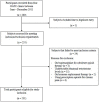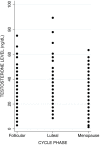Methadone induces testosterone suppression in patients with opioid addiction
- PMID: 25155550
- PMCID: PMC4143768
- DOI: 10.1038/srep06189
Methadone induces testosterone suppression in patients with opioid addiction
Abstract
Sex hormones may have a role in the pathophysiology of substance use disorders, as demonstrated by the association between testosterone and addictive behaviour in opioid dependence. Although opioid use has been found to suppress testosterone levels in men and women, the extent of this effect and how it relates to methadone treatment for opioid dependence is unclear. The present multi-centre cross-sectional study consecutively recruited 231 patients with opioid dependence from methadone clinics across Ontario, Canada between June and December of 2011. We obtained demographic details, substance use, psychiatric history, and blood and urine samples from enrolled subjects. The control group included 783 non-opioid using adults recruited from a primary care setting in Ontario, Canada. Average testosterone level in men receiving methadone treatment was significantly lower than controls. No effect of opioids including methadone on testosterone level in women was found and testosterone did not fluctuate significantly between menstrual cycle phases. In methadone patients, testosterone level was significantly associated with methadone dose in men only. We recommend that testosterone levels be checked in men prior and during methadone and other opioid therapy, in order to detect and treat testosterone deficiency associated with opioids and lead to successful methadone treatment outcomes.
Figures



References
-
- Fischer B., Medved W., Gliksman L. & Rehm J. Illicit opiate users in Toronto: a profile of current users. Addict Res 7, 377–415 (1999).
-
- United States Department of Health and Human Services. Substance Abuse and Mental Health Services Administration. Office of Applied Studies. National Household Survey on Drug Abuse, 2000. Ann Arbor, MI: Inter-university Consortium for Political and Social Research, 10.3886/ICPSR03262.v5 (2013). Date of access: 25/02/2014.
-
- Maremmani I. et al. Differential substance abuse patterns distribute according to gender in heroin addicts. J Psychoactive Drugs 42, 89–95 (2010). - PubMed
Publication types
MeSH terms
Substances
Grants and funding
LinkOut - more resources
Full Text Sources
Other Literature Sources
Medical

